Physical Address
304 North Cardinal St.
Dorchester Center, MA 02124
Endometrial carcinoma is the most common malignancy of the female genital tract. In the United States the lifetime risk of endometrial cancer is 3%.
Most women who develop endometrial cancer are aged 50 to 65 years.
Women with Lynch syndrome (hereditary nonpolyposis colorectal cancer syndrome) have a 40% to 60% lifetime risk of endometrial cancer, which is similar to their lifetime risk of colon cancer.
Chronic unopposed estrogen stimulation of the endometrium leads to endometrial hyperplasia and in some cases adenocarcinoma. Other important predisposing factors include obesity, nulliparity, late menopause, and diabetes.
The risk of a woman developing endometrial carcinoma is three times higher if her body mass index is greater than 30 kg/m 2 .
Tamoxifen use increases the risk of endometrial neoplasia two- to threefold.
The primary symptom of endometrial carcinoma is postmenopausal bleeding. Women with abnormal bleeding should undergo endometrial sampling to rule out endometrial pathologic conditions.
Cytologic atypia in endometrial hyperplasia is the most important factor in determining malignant potential.
Studies have found that there is a 40% concurrent rate of endometrial cancer in patients with a preoperative diagnosis of complex atypical hyperplasia.
Prognosis in endometrial carcinoma is related to tumor grade, tumor stage, histologic type, and degree of myometrial invasion.
Older patients with atypical hyperplasia are at increased risk of malignant progression compared with younger patients.
A key determinant of the risk of nodal spread of endometrial carcinoma is depth of myometrial invasion, which is often related to tumor grade.
Well-differentiated (grade 1) endometrial carcinomas usually express steroid hormone receptors, whereas poorly differentiated (grade 3) tumors usually do not express receptors.
Uterine serous carcinoma is an aggressive histologic subtype associated with metastatic disease even in the absence of myometrial invasion.
Ninety percent of recurrences of adenocarcinoma of the endometrium occur within 5 years.
Overall survival rates for patients with adenocarcinoma of the endometrium by stage are as follows: stage I, 86%; stage II, 66%; stage III, 44%; stage IV, 16% (overall 72.7% 5-year survival rate combining clinical and operative staging systems).
Histologic variants of endometrial carcinoma with a poor prognosis include uterine serous carcinoma and clear cell carcinoma.
The most common sites of distant metastasis of adenocarcinoma of the endometrium are the lung, retroperitoneal nodes, and abdomen.
Primary treatment of endometrial cancer includes hysterectomy, bilateral salpingo-oophorectomy, lymph node assessment, and resection of all disease. The exceptions include young premenopausal women with stage I and grade 1 endometrial carcinoma associated with endometrial hyperplasia and women with increased risk of mortality secondary to medical comorbidities.
Postoperative adjuvant radiation has not been shown to improve overall survival.
Patients with high-stage or recurrent disease should be treated with a multimodal approach including chemotherapy, radiation, and/or hormone therapy.
Uterine sarcomas comprise less than 5% of uterine malignancies.
Uterine sarcomas are treated primarily by operation including removal of the uterus, tubes, and ovaries.
Endometrial stromal sarcomas are low-grade sarcomas with an indolent course.
Multiagent chemotherapeutic regimens are usually prescribed for metastatic sarcomas; complete responses are rare and usually temporary.
Endometrial carcinoma is the most common malignancy of the lower female genital tract in the United States. Lifetime risk for endometrial cancer is 3%, and approximately 61,880 new cases develop in the United States each year, according to 2019 figures from the American Cancer Society. The rising rates of obesity in the United States correlate with rising rates of endometrial cancer. Approximately 12,000 deaths occurred annually in women with uterine cancer, more than for cervical cancer (4250) and fewer than the estimated 14,000 for ovarian cancer.
This chapter reviews the clinical and pathologic features of endometrial hyperplasias and carcinomas, the factors that contribute to the development of these diseases, and the appropriate methods of management. Sarcomas of the uterus and their clinical behavior and therapy are also presented.
Adenocarcinoma of the endometrium affects women primarily in the perimenopausal and postmenopausal years and is most often diagnosed in those between ages 50 and 65; however, these cancers can also develop in young women during their reproductive years. Approximately 5% of the cases are diagnosed in women younger than 40 and approximately 10% to 15% in women younger than age 50. Women diagnosed before age 50 years are also at risk for synchronous ovarian cancer ( ). Fig. 32.1 plots a typical age–incidence curve for cancers of the endometrium. The curve rises sharply after age 45 and peaks between 55 and 60; then there is a gradual decrease.
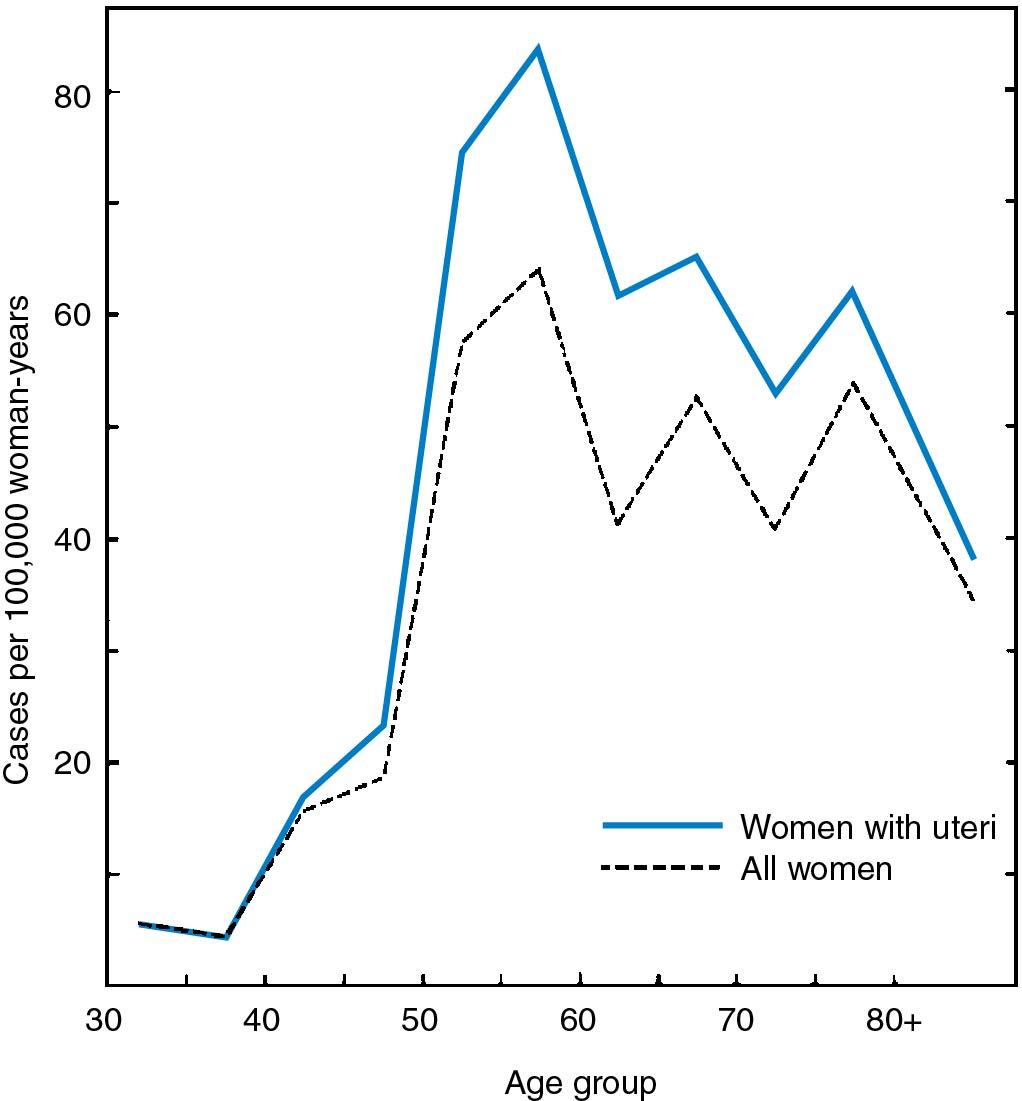
Complex atypical hyperplasia, also referred to as endometrial intraepithelial neoplasia (EIN), is a precursor to endometrioid endometrial cancer. Some endometrial cancers develop without previous hyperplasia. These non–estrogen-related carcinomas with serous histology tend to be poorly differentiated and clinically more aggressive.
Multiple factors increase the risk of developing endometrial carcinoma ( Box 32.1 ). Obesity is a strong risk factor for endometrial cancer. Women who are obese (body mass index > 30) have a two- to threefold increased risk, and this risk increases with increasing weight. The association is believed to be due in part to increased circulating estrogen levels that result from conversion of androstenedione to estrone in the adipose tissue, decreased sex hormone-binding globulin, and other factors, including insulin resistance. Although more historical than clinically relevant, unopposed estrogen stimulation is strongly associated with endometrial cancer, increasing the risk four to eight times for a woman using estrogen alone for menopausal replacement therapy. The risk increases with higher doses of estrogen (>0.625 mg conjugated estrogens) and more prolonged use but can be markedly reduced with the use of progestin (see Chapter 42 , Menopause). Similarly, combination (progestin-containing) oral contraceptives decrease the risk, as noted by Grimes and Economy, with most studies showing a relative risk reduction to approximately 0.5 ( ). The protection begins after 1 year of use and lasts approximately 15 years after discontinuation. Other conditions leading to long-term estrogen stimulation of the endometrium, including the polycystic ovary syndrome (Stein-Leventhal syndrome) and the much more rare feminizing ovarian tumors, are also associated with increased risk of endometrial carcinoma.
Obesity (2-5 times)
Nulliparity (2-3 times)
Diabetes (2.8 times)
Lynch syndrome
Insulin resistance
Estrogen-secreting ovarian tumors
Polycystic ovary syndrome
Tamoxifen therapy for breast cancer
Unopposed estrogen stimulation
Unopposed menopausal estrogen (4-8 times) replacement therapy
Ovulation
Progestin therapy
Combination oral contraceptives
Menopause before 49 years
Multiparity
Patients who receive the selective estrogen receptor modulator (SERM) tamoxifen are also at increased risk of developing endometrial carcinoma. In the National Surgical Adjuvant Bowel and Breast P-1 trial examining tamoxifen as a chemopreventive agent, risk of endometrial cancer was elevated 2.5-fold. Risk increased with duration of use. The majority of endometrial cancers that developed in tamoxifen users had endometrioid histology and were of low grade and stage; however, high-grade endometrial cancers and sarcomas have also been reported in women taking tamoxifen. There is a high false-positive rate with transvaginal ultrasonography as a screening technique because tamoxifen causes subendometrial cyst formation, which makes the endometrial stripe appear abnormally thick. Women taking tamoxifen should be counseled about the increased risk of endometrial cancer, and all women on tamoxifen who have irregular vaginal bleeding (if premenopausal) or any vaginal bleeding (if postmenopausal) should undergo endometrial sampling or dilation and curettage (D&C).
Various other factors increase the risk of endometrial cancer. Nulliparity is associated with a twofold increased risk in endometrial cancer. Diabetes increases the risk by 2.8-fold and has been found to be an independent risk factor. Hypertension is often related to obesity and diabetes but is not considered an independent risk factor. Insulin resistance or metabolic syndrome has also been recognized as a risk factor for endometrial cancer. Regarding racial factors, the incidence of endometrial cancer among white women is approximately twice the rate in black women; however, studies of Hill and coworkers demonstrated that black women tend to develop a much higher percentage of poorly differentiated tumors. The National Cancer Database report by Partridge and colleagues confirmed that patients who are black and have a low income do present at an advanced stage and have a poor survival compared with non-Hispanic white patients. The difference in survival between black and non-Hispanic white women does not appear to be solely based on access to care issues, and there are likely biologic differences that account for the disparity in survival.
Lynch syndrome, or hereditary nonpolyposis colorectal cancer (HNPCC) syndrome, is an autosomal dominant hereditary cancer susceptibility syndrome caused by a germline defect in a DNA mismatch repair gene ( MLH1, MSH2, MSH6, or PMS2 ). Women with MLH1 or MSH2 mutations have a 40% to 60% lifetime risk for developing endometrial cancer, a 40% to 60% lifetime risk of developing colon cancer, and a 12% lifetime risk of developing ovarian cancer. This contrasts sharply with the general population risk of 3% for endometrial cancer, 5% for colon cancer, and 1.7% risk of ovarian cancer. Women with MSH6 mutations have a high rate of endometrial cancer, but the occurrence is often at a later age. Endometrial cancers in Lynch syndrome can be of any histology and grade. Broaddus and Lu reported that although most endometrial cancers in women with Lynch syndrome were early stage, approximately one-fourth were high grade, high stage, or of a poor histologic type ( ). Given that there are few longitudinal cohort studies, screening recommendations for gynecologic cancers are based on expert opinion and can include endometrial biopsy every 1 to 2 years. Schmeler reported on the efficacy of prophylactic hysterectomy and salpingo-oophorectomy to decrease endometrial and ovarian cancer risk ( ). Women with Lynch syndrome should be offered this option after childbearing is complete. Lynch syndrome is likely to account for approximately 2% of all endometrial cancers. Women with endometrial cancer and a family history of colon, endometrial, or ovarian cancer should be referred for genetic evaluation and colonoscopy. In addition, women who have a personal history of both endometrial and colon cancer have a significant risk for Lynch syndrome and should be referred. Although synchronous endometrial and ovarian cancers are fairly common, Soliman and colleagues estimated the risk of Lynch syndrome in this cohort to be less than 10% ( ).
In 2013 the Cancer Genome Atlas Program published a comprehensive genomic analysis on more than 300 endometrial cancers ( ). Four molecular subtypes emerged: polymerase-epsilon (POLE) ultramutated, microsatellite instability high (MSI-H), copy number low, and copy number high. Copy number–low tumors include most low-grade, estrogen receptor–positive endometrial cancers, which contain defects in the PTEN and KRAS pathways. Copy number–high tumors include endometrial cancers of serous histologic type, which contain p53 mutations, and high-grade endometrioid cancers. MSI-H tumors can occur in women with Lynch syndrome; more commonly, they result from somatic hypermethylation of the MLH1 promoter. Finally, a small subset of endometrial cancers with mutations in POLE are associated with a large number of mutations and have an improved clinical outcome.
The normal morphologic changes that occur in the endometrium during the menstrual cycle are reviewed in Chapter 4 , Reproductive Endocrinology. Endometrial hyperplasia is believed to result from an excess of estrogen or an excess of estrogen relative to progestin, such as occurs with anovulation. In 2014 the World Health Organization changed its categorization of endometrial hyperplasias. There are two important separate categories: hyperplasia without atypia and hyperplasia with atypia, often referred to as complex atypical hyperplasia or EIN.
Hyperplasia without atypia encompasses the older terms simple hyperplasia and complex hyperplasia without atypia. The endometrium may have dilated glands with some outpouching and abundant endometrial stroma ( Fig. 32.2 ). Alternatively, the glands may demonstrate crowding with very little endometrial stroma, a very complex gland pattern, and outpouching formations but no cytologic atypia ( Fig. 32.3 ).
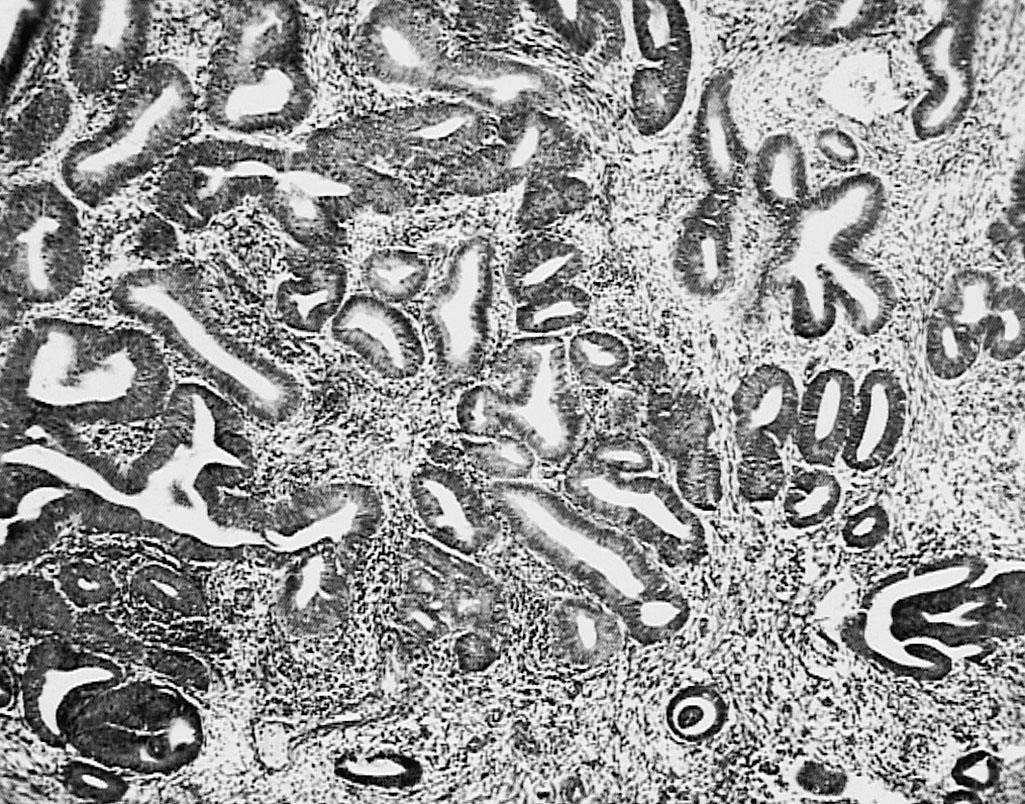
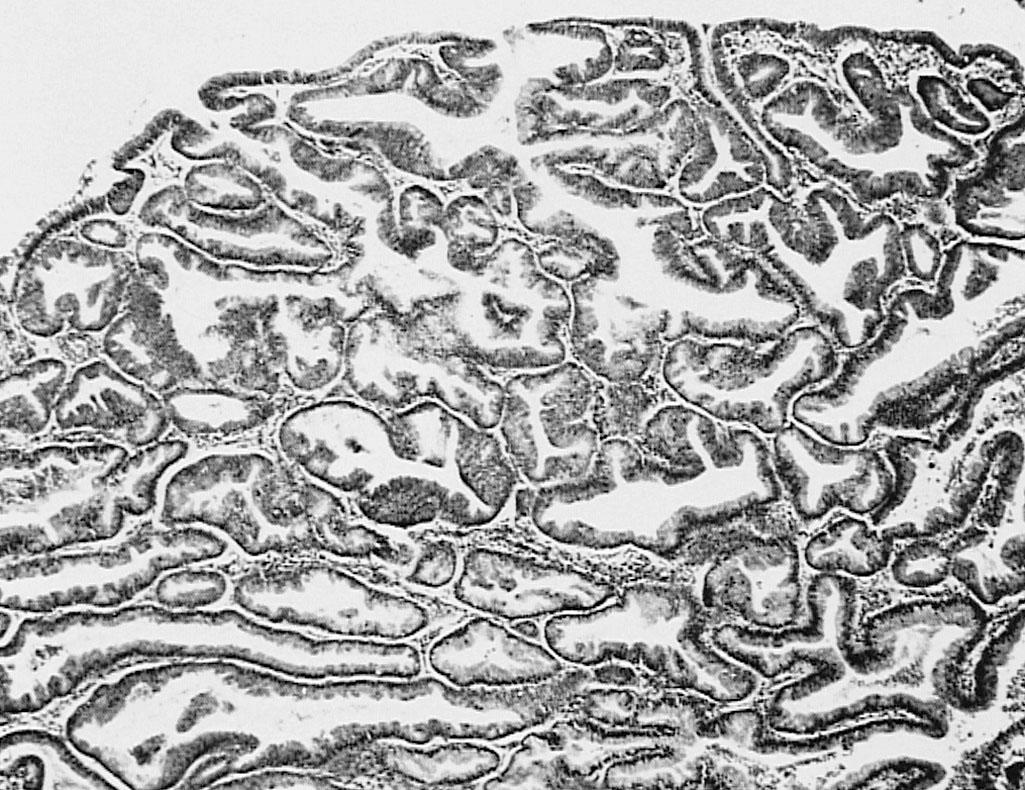
Hyperplasia with atypia refers to hyperplasias that contain glands with cytologic atypia and are considered premalignant. There is an increase in the nuclear/cytoplasmic ratio with irregularity in the size and shape of the nuclei ( Fig. 32.4 ). The term complex atypical hyperplasia can also be used, as well as the term endometrial intraepithelial neoplasia (EIN ).
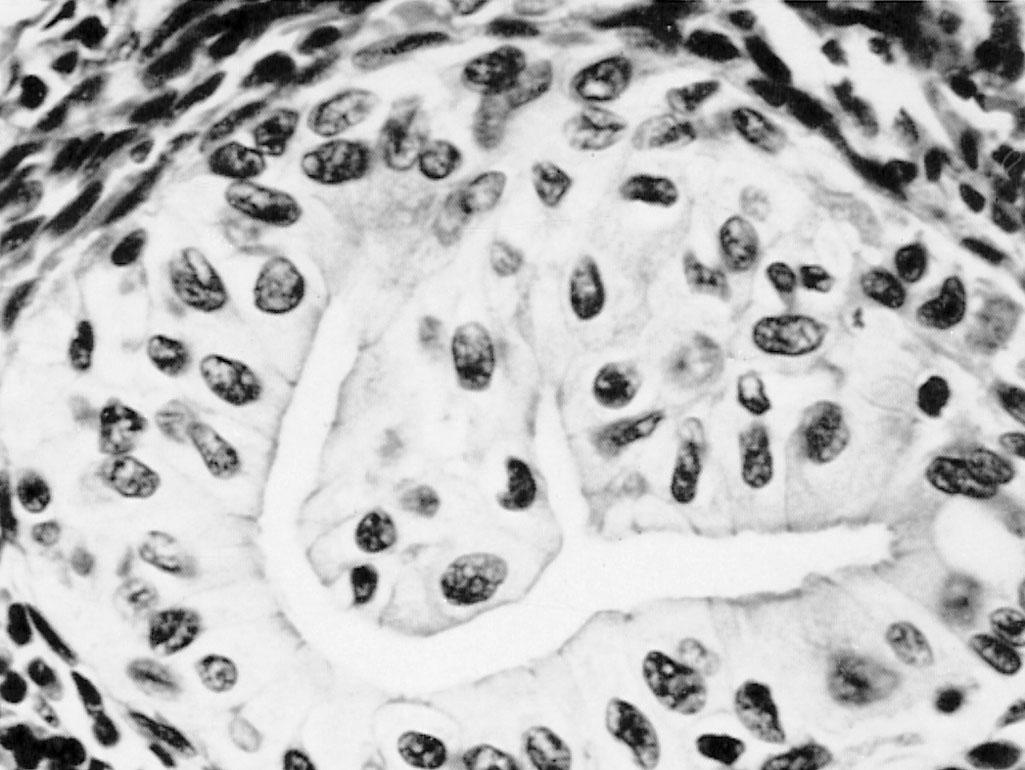
The rate at which endometrial hyperplasia progresses to endometrial carcinoma has not been accurately determined because many of the studies have been retrospective and were based on the 1994 classification of endometrial hyperplasia. Kurman and associates studied 170 patients with endometrial hyperplasia diagnosed by D&C at least 1 year before hysterectomy. Overall, complex atypical hyperplasias had the highest risk of progression to carcinoma. Simple hyperplasia had a 1% rate of progression to cancer, complex hyperplasia without atypia had a 3% rate of progression to cancer, and complex atypical hyperplasia had a 29% rate of progression to cancer. Lacey found up to 27.5% cumulative risk of endometrial cancer in women with atypical hyperplasia, compared with a 4.6% cumulative risk of endometrial cancer in women with nonatypical hyperplasia ( ). In addition to possible progression to cancer, 42% of women who undergo hysterectomy for complex atypical hyperplasia have a concurrent endometrial cancer in their hysterectomy specimen. This high rate of cancer suggests that complex atypical hyperplasia often may be present with low-grade endometrial cancer and that endometrial sampling may not identify an endometrial cancer when admixed with a complex atypical hyperplasia. Clearly there is a spectrum of histologic types that make a definitive diagnosis of atypical hyperplasia/EIN difficult, and the clinician must be aware of this fact when planning management strategies.
Abnormal vaginal bleeding is the most common symptom of endometrial hyperplasia. In younger patients, hyperplasia may develop during anovulatory cycles and may be detected after prolonged periods of oligomenorrhea or amenorrhea. It can occur at any time during the reproductive years but is most common with abnormal bleeding in the perimenopausal period. Premenopausal women with irregular vaginal bleeding and postmenopausal women with any vaginal bleeding should be evaluated with an office endometrial sampling or a D&C. The office sampling instruments, such as a thin plastic Pipelle, are introduced through the cervical os into the endometrial cavity and can provide sufficient tissue for accurate histologic diagnoses. Studies have had conflicting results regarding whether a D&C provides more sensitivity in detecting cancer compared with an office Pipelle procedure. Importantly, both modalities still miss a significant number of cancers. Suh-Bergmann reported that preoperative D&C lowered the risk of an unrecognized cancer in women with complex atypical hyperplasia from 45% to 30%.
Transvaginal ultrasonography has been evaluated as an adjunct for the diagnosis of endometrial hyperplasia and cancer. In postmenopausal women with any vaginal bleeding, Gull and colleagues found that an endometrial stripe of less than 4 mm had a 100% negative predictive value. A finding of endometrial thickness less than 4 mm is a reasonable predictor of lack of endometrial pathologic changes, even in a postmenopausal patient with bleeding; however, persistent vaginal bleeding should lead to endometrial sampling regardless of the ultrasound findings. In addition, measurement of endometrial stripe in a premenopausal woman is not clinically useful.
The therapy employed for endometrial hyperplasia depends on the patient’s age, desire for future childbearing, comorbidities, and the type of hyperplasia. For younger women with benign endometrial hyperplasia, the risk of developing endometrial cancer is extremely low and patients can be treated with progestins or combination oral contraceptive agents. For patients with hyperplasia with atypia/EIN, the risk of developing endometrial cancer may be close to 30%.
For patients who do not desire future childbearing, hysterectomy is the definitive treatment. Oophorectomy can be considered, but long-term risks and benefits should be discussed with the patient. Because of the 40% risk of a concomitant cancer, many surgeons send the uterus for frozen section evaluation intraoperatively, with staging as needed.
Women who desire preservation of childbearing function or who are poor surgical candidates are treated with progestin therapy, usually megestrol acetate 40 mg four times a day. A common alternative is the use of a progestin-eluting intrauterine device (IUD), which has the benefit of local delivery to the endometrium with minimal systemic side effects and which has an overall response rate for women with complex atypical hyperplasia of 80% ( ). One study found a higher rate of regression in patients treated with a progestin-eluting IUD compared with those treated with oral progestins (Gallos, 2013). Patients require long-term follow-up and periodic sampling. In these patients the risk factors that led to the development of hyperplasia with atypia/EIN are likely to remain. In those for whom progestin therapy is ineffective, hysterectomy should be considered.
Postmenopausal bleeding, abnormal premenopausal bleeding, and perimenopausal bleeding are the primary symptoms of endometrial carcinoma.
The diagnosis of endometrial carcinoma is established by histologic examination of the endometrium. Initial diagnosis often can be made on an outpatient basis, with an office endometrial biopsy. A routine cytologic examination (Papanicolaou [Pap] smear) from the exocervix, which screens for cervical neoplasia, detects endometrial carcinoma in only approximately 50% of the cases.
If adequate outpatient evaluation cannot be obtained or if the diagnosis or cause of the abnormal bleeding is not clear from the tissue obtained, a hysteroscopy and D&C should be performed. If cervical involvement is suspected, the endocervix should be sampled first, followed by hysteroscopy to visualize the endometrial cavity and then a complete uterine curettage.
The various types are listed in Box 32.2 . Fig. 32.5 illustrates typical adenocarcinomas of the endometrium and demonstrates varying degrees of differentiation (G1, well differentiated; G2, intermediate differentiation; G3, poorly differentiated). Grading is determined by the percentage of solid components found in the tumor: Grade 1 has less than 5% solid components, grade 2 has 6% to 50% solid components, and grade 3 has more than 50% solid components.
Typical endometrioid adenocarcinoma
Adenocarcinoma with squamous elements *
Clear cell carcinoma
Serous carcinoma
Secretory carcinoma
Mucinous carcinoma
Squamous carcinoma
* Previously termed adenoacanthoma or adenosquamous carcinoma.
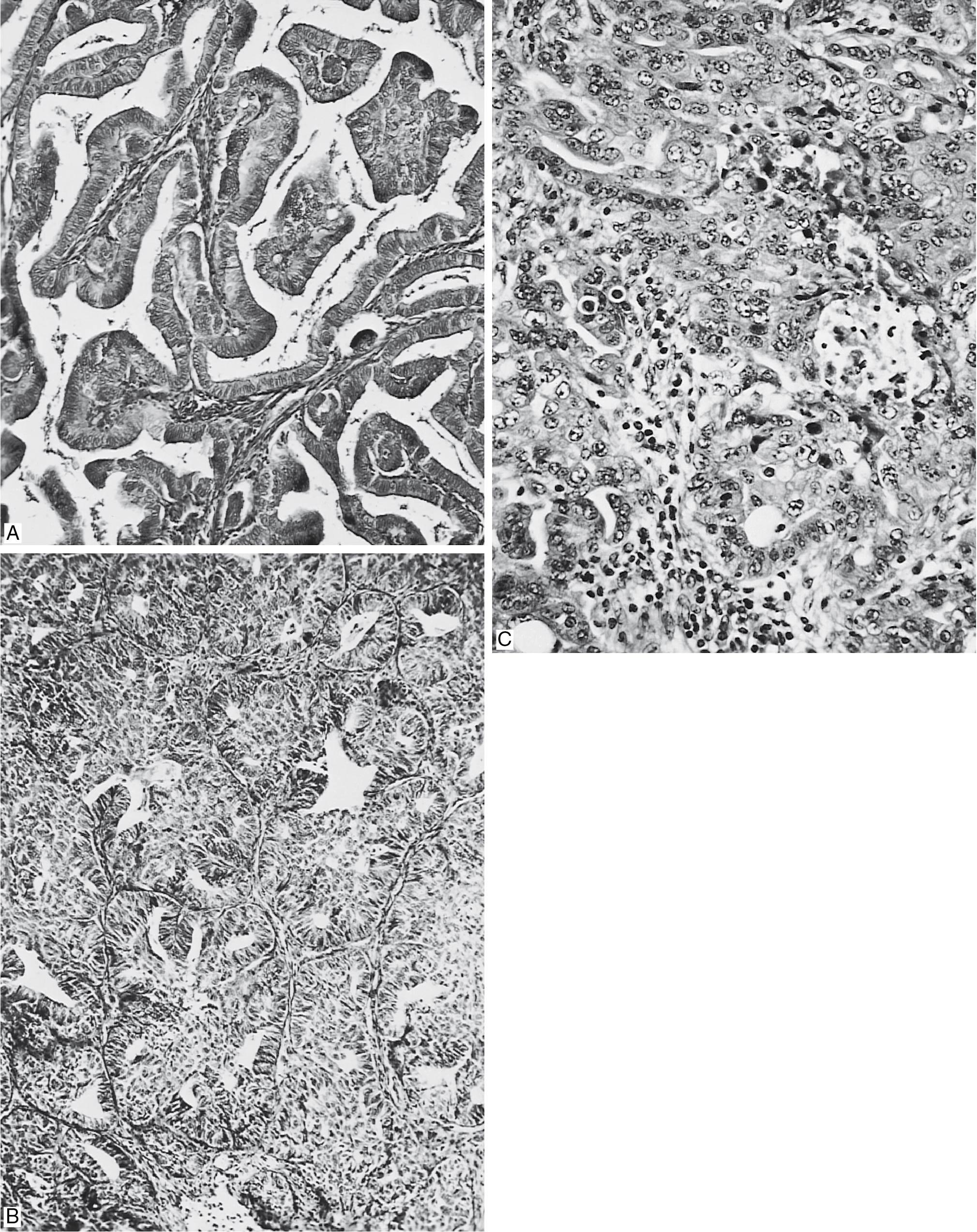
Squamous epithelium commonly coexists with the glandular elements of endometrial carcinoma. Previously the term adeno-acanthoma was used to describe a well-differentiated tumor and adenosquamous carcinoma to describe a poorly differentiated carcinoma with squamous elements. More recently, the term adenocarcinoma with squamous elements has been used with a description of the degree of differentiation of both the glandular and squamous components. Zaino and colleagues, in a Gynecologic Oncology Group (GOG) study of 456 cases with squamous elements, showed that prognosis was related to the grade of the glandular component and the degree of myometrial invasion. They suggested the term adenocarcinoma with squamous differentiation, and this has been generally adopted.
Uterine serous carcinomas are a highly virulent and a less common histologic subtype of endometrial carcinomas (5% to 10%). These tumors histologically resemble papillary serous carcinomas of the ovary ( Fig. 32.6 ). Slomovitz and associates evaluated 129 patients with uterine serous carcinoma (USC) and found a high rate of extrauterine disease even in cases without myometrial invasion. They recommend a thorough operative staging (see the next section) with all cases of these tumors because of the high risk of extrauterine disease even in cases where the tumor is admixed with other histologic types (endometrial and/or clear cell).
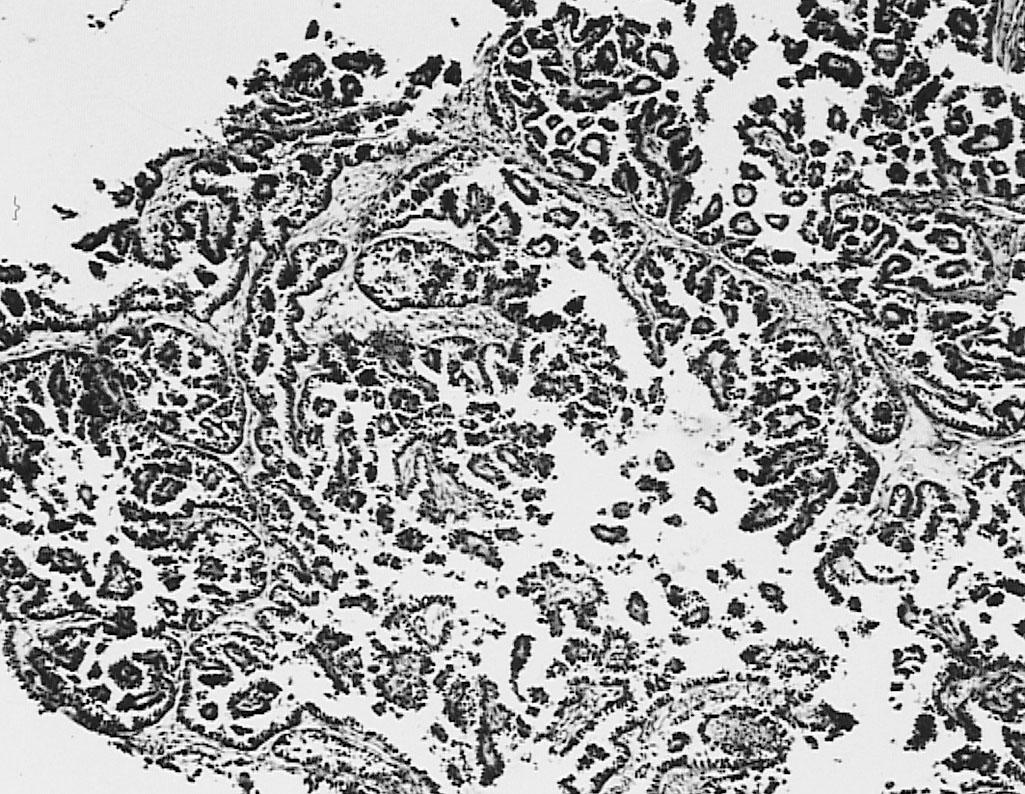
Clear cell carcinomas of the endometrium are less common (<5%). Histologically they resemble clear cell adenocarcinomas of the ovary, cervix, and vagina; they tend to develop in postmenopausal women and carry a prognosis much worse than typical endometrial adenocarcinomas. Survival rates of 39% to 55% have been reported, much less than the 65% or better usually recorded for endometrial carcinoma. When diagnosed at an early stage, however, prognosis can be favorable. Armbruster and colleagues reviewed 112 cases of clinical early stage clear cell cancer of the uterus. Patient with pure clear cell or mixed tumors with more than 50% clear cell type had an overall survival approaching 10 years. Women older than 70 years had the worst prognosis
In 2009, a revised International Federation of Gynecology and Obstetrics (FIGO) surgical staging classification was introduced in which the staging was modified to better define clinically relevant risk strata based on the FIGO Annual Report and other supporting publication ( Table 32.1 ).
| Stages | Characteristic |
|---|---|
| I * | Tumor confined to the corpus uteri |
| IA * | No or less than half myometrial invasion |
| IB * | Invasion equal to or more than half of the myometrium |
| II * | Tumor invades cervical stroma but does not extend beyond the uterus † |
| III * | Local and/or regional spread of the tumor |
| IIIA * | Tumor invades serosa of the corpus uteri and/or the adnexae ‡ |
| IIIB * | Vaginal and/or parametrial involvement ‡ |
| IIIC * | Metastases to pelvic and/or paraaortic lymph nodes ‡ |
| IIIC1 * | Positive pelvic nodes |
| IIIC2 * | Positive paraaortic lymph nodes with or without positive pelvic lymph nodes |
| IV * | Tumor invades bladder and/or bowel mucosa and/or distant metastasis |
| IVA * | Tumor invades bladder and/or bowel mucosa |
| IVB * | Distant metastases, including intraabdominal and/or inguinal lymph nodes |
† Endocervical glandular involvement only should be considered stage I and no longer stage II.
‡ Positive cytologic testing has to be reported separately without changing the stage.
Become a Clinical Tree membership for Full access and enjoy Unlimited articles
If you are a member. Log in here